Are you shopping for new cookware and knives but can’t decide between Calphalon and Made In?
Both are well respected, high-quality brands. But is one better than the other?
This in-depth comparison of Calphalon vs. Made In will walk you through the key differences between their cookware and knives.
You’ll learn how they compare in terms of product offerings, materials, construction, design, performance, price, and more. You’ll also learn about the downsides of each brand.
At the end, I’ll share my recommendation, purely based on the facts.
Use the links below to navigate the comparison:
- Calphalon vs. Made In: Cookware
- Calphalon vs. Made In: Kitchen Knives
- Bottom Line: Should You Buy Calphalon or Made In?
Calphalon vs. Made In: Cookware

Calphalon and Made In are both popular cookware brands. But they have key differences in offerings, materials, construction, and design.
While Calphalon features multiple collections, Made In’s cookware presentation is more streamlined. Let’s start the comparison by taking an in-depth look at each brand’s cookware offerings.
Cookware Offerings
Calphalon is known for its hard-anodized aluminum, PTFE-based non-stick cookware. It’s the bulk of what the Ohio-based cookware brand offers. However, Calphalon also features stainless clad, ceramic non-stick, and cast iron cookware.
Calphalon has several cookware collections, each with distinct design features and construction.
Made In has non-stick, stainless clad, carbon steel, copper, and enameled cast iron cookware but doesn’t have multiple collections like Calphalon.
Let’s get into some details about both cookware brands’ options.
Calphalon Offerings:
- Calphalon Elite: This is the top-of-the-line hard-anodized collection from Calphalon. It’s exclusively sold at Williams-Sonoma and features a textured non-stick surface for improved searing. It’s also metal utensil safe.
- Calphalon Signature: A high-end line that includes hard-anodized, 3-layer non-stick and 5-ply stainless steel cookware.
- Calphalon Premier: A mid-range collection of hard-anodized, 3-layer non-stick and 3-ply stainless steel cookware. Premier Space-Saving Hard-Anodized Cookware features stackable sets designed to save space in compact kitchens.
- Calphalon Classic: Classic is the entry-level, more affordable collection. It contains cookware sets and individual pieces made from hard-anodized, dual-layer non-stick, oil-infused ceramic non-stick, and stainless steel.
- Select by Calphalon: The only collection from Calphalon that features hard-anodized non-stick, oil-infused ceramic non-stick, stainless steel, and bare, seasoned cast iron cookware. Calphalon Select Space-Saving cookware sets are stackable with stay-cool silicone handles.
- Simply Calphalon: A budget-friendly set of hard-anodized, dual-layer non-stick cookware offering easy food release and a simple yet stylish design.
Made In Offerings:
- Made In Non-Stick: All non-stick offerings are multi-layer and PTFE-based. They feature two colors of non-stick: graphite and harbour blue.
- Made In Stainless Clad: Each stainless steel pot and pan from Made In features 5-ply construction. A brushed stainless finish with polished steel handles is the signature look.
- Carbon Steel: The blue carbon steel cookware is lightweight, has excellent heat control, and is oven-safe up to 1200°F — the highest temperature threshold in the brand. The carbon steel line features a variety of cookware such as frying pans, a wok, a paella and griddle pan, and a roasting pan.
- Copper: This is elegant cookware with superior heat conductivity and a brilliant shine. It has a 90:10 ratio of copper to stainless steel composition.
- Enameled Cast Iron: Made In’s limited-edition enameled cast iron Dutch oven boasts a black enamel interior, a navy blue or red enamel exterior, and a brass-colored knob. It’s one of the best Le Creuset alternatives.
Materials and Construction
Both brands differ in materials and construction, but they have a few things in common. Here’s what each brand offers.
Calphalon Materials and Construction
In 1968, Calphalon’s founder, Ronald M. Kasperzak, invented hard-anodized cookware — it continues to be the brand’s primary offering.
Calphalon’s non-stick offerings have a hard-anodized cookware base. While you can choose between PTFE-based and ceramic non-stick coatings (in the Classic and Select lines), more offerings contain PTFE.

The higher-end collections, such as Calphalon Elite and Signature, are made with 3-layer, PTFE-based, PFOA-free non-stick. Lower-priced offerings, such as Simply Calphalon and Classic, feature dual-layer non-stick.

Calphalon offers a few stainless clad cookware pieces and sets across several collections. Some are fully-clad (3-ply or 5-ply), but others have impact-bonded bases. An impact-bonded base is a multi-layer metal disc on the bottom of a pot or pan.
For example, Calphalon Classic stainless has an impact-bonded base and will not heat as evenly as 5-ply stainless clad cookware.
Finally, Calphalon offers one pre-seasoned cast iron pan in the Select by Calphalon collection.
Made In Materials and Construction
Made In offers multiple cookware types — from stainless clad to enameled cast iron.
Its cookware is constructed of high-quality stainless steel that is fully-clad, meaning it has layers of bonded metal from the bottom up to the rim. While some Calphalon pans are made with three bonded layers (3-ply), all Made In stainless clad cookware is made of five layers (5-ply).
More specifically, the stainless clad interiors employ 18/10 stainless steel — an ideal chrome to nickel composition for high corrosion resistance, durability, and luster. Stainless exteriors are made from 430 steel, a magnetic steel for induction compatibility. The core is three layers of heat-conducting and retaining aluminum.
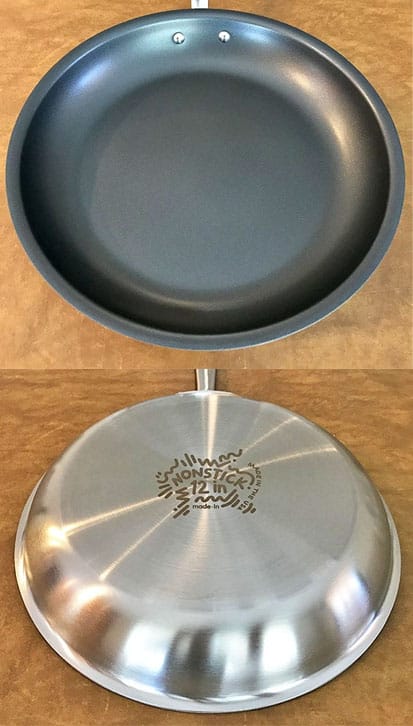
Made In non-stick cookware features the same ultra-durable 5-ply base, but the interior is coated with multiple layers of PTFE-based non-stick cookware. Due to the steel base, it’s compatible with all cooktops, including induction. Calphalon non-stick pans are not compatible with induction cooktops.

Made In’s copper cookware is 90% copper, which provides superior heat response and control. The remaining 10% is stainless steel. While the cookware isn’t suitable for induction stoves, the 2mm-thick pan wall construction holds heat well and can be used on any other cooktop.
Of the two brands, only Made In features blue carbon steel cookware. Carbon steel offers the durability, heat retention, and high-heat tolerance of cast iron; the quick, even heating of stainless steel; and the food release of non-stick that gets better as time goes by (and the layers of seasoning build).

Finally, Made In released enameled cast iron cookware in 2022.

The 5.5-quart round Dutch oven has 6mm-thick pan walls and a heavy-duty, self-basting lid to cook meals low and slow. It’s constructed from high-performance cast iron and has an attractive hand-enameled outer finish.
Design
Calphalon has a traditional cookware design. It has a simple elegance in classic black or gray hues, brushed stainless, or polished stainless steel.

In contrast, Made In cookware is sleek, modern, and contemporary. It features exterior finishes such as brushed stainless, polished copper, and navy blue enamel.
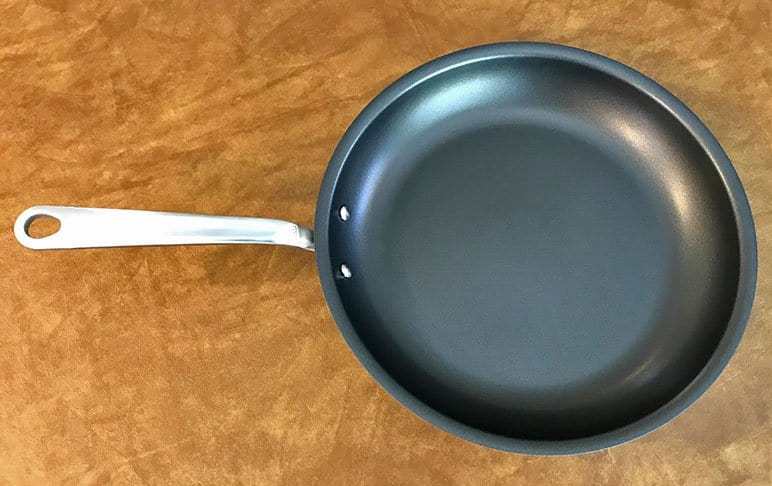

Both brands feature ergonomic, stay-cool handles attached with double rivets. In addition, Made In’s carbon steel pans feature three rivets to secure the handles.

Calphalon handles are either brushed or polished stainless steel. Some also incorporate black silicone into the handle designs. Made In handles are brushed (stainless clad and non-stick) or polished stainless steel (copper).
Calphalon lids are made from tempered glass and trimmed in stainless steel. Most Made In lids are stainless steel, but they also offer a universal silicone lid that fits most pieces.

Both brands have their respective logos stamped on the bottoms of the cookware.


Made In stainless clad, non-stick, and carbon steel fry pans are the brand’s most popular offerings. But the copper cookware stands out for its stunning, shiny finish and brushed stainless interior (although it’s very expensive).

In terms of pan shapes, Made In’s pans have deeper sides that minimize splatter and keep food in the pan. All Made In fry pans feature flared rims; many Calphalon fry pans have straight rims.

Calphalon doesn’t offer carbon steel, so if it’s something you’re interested in, take a good look at Made In. If you’re not familiar with carbon steel, it changes in appearance the more you use it. It forms a patina as it matures, taking it from a very modern look to a more rustic appeal.

Perfomance
Made In and Calphalon pans both perform exceptionally well in the kitchen. However, they conduct and retain heat differently due to their construction (Made In’s 5-ply stainless steel vs. Calphalon’s hard-anodized aluminum).
To find out which brand conducts and retains heat, I conducted two simple tests.
First, I poured two cups of cold water into a 12-inch Made In pan and 12-inch Calphalon pan. I set both pans on the stove and set the heat to the highest setting.
The Calphalon pan took two minutes and 44 seconds to boil the water. The Made In pan boiled the water in two minutes and 21 seconds.
The Made In pan not only boiled the water faster, but it distributed heat more evenly. The bubbles in the Made In pan were evenly distributed across the cooking surface.
With the Calphalon pan, the bubbles concentrated at the edges, indicating a cold spot in the middle.

To measure each brand’s heat retention, I removed both pans from the stove and set them on the counter.
After five minutes, the water in the Calphalon pan measured 112.8°F. The water in the Made In pan was much warmer at 121.1°F.
After ten minutes, the water in the Calphalon pan measured 101.1°F. The water in the Made In pan was much warmer at 106.6°F.
Based on my tests, Made In cookware heats faster and more evenly than Calphalon and retains heat better.
Where It’s Made
Calphalon manufactures its Elite, Commercial, and Signature non-stick (individual pieces only) collections in the United States. All other collections are made in China.
Made In cookware is made in multiple locations. Its stainless clad and non-stick cookware is manufactured in the U.S. and Italy. The copper, carbon steel, and enameled cast iron Dutch oven are all produced in France.
Common Complaints
This section breaks down the most common complaints about Calphalon and Made In cookware.
Some people complain about Calphalon’s:
- Durability: Calphalon’s most popular cookware is non-stick. No matter how durable the non-stick is, it will eventually need replacement — usually within one to five years. Although Calphalon touts some of its collections as metal utensil-safe, you’ll extend the life of your pans by using wood or silicone utensils and handwashing them without abrasive cleaners or tools.
- Appearance: Hard-anodized pans stain easily compared to other materials. A relatively new pan can quickly look old because the exterior shows every imperfection and mark. To keep them looking their best, use these proven cleaning techniques.
- Compatibility: None of the non-stick cookware is induction-compatible due to the aluminum base. It works great on gas or electric stoves but won’t heat properly on induction.
- Uneven heating: The Classic stainless collection doesn’t heat as evenly as a fully-clad pan due to its impact-bonded base.
- Made in China: There was a time when Calphalon cookware was made in Ohio. Now, most collections are made in China. Only the Elite and Signature non-stick lines are made in the U.S.
When it comes to Made In, people don’t like:
- Food sticks: Some customers complain about food sticking to Made In’s stainless steel cookware. To be fair, this is a common issue with stainless steel due to the tiny pores in the cooking surface. Check out this article to learn how to minimize sticking.
- Lack of choices: Made In doesn’t have multiple collections and has fewer design options than other established brands. It’s worth noting, however, that the brand launched in 2016 with a handful of options for stainless steel and non-stick. Over the years, they’ve slowly rolled out more options, so expect more variety in the future.
- The cost: Made In is not as expensive as some of the high-end brands it competes with, but it’s not cheap — especially the copper and stainless clad cookware. The priority is the quality of the cookware, not the price.
Price
With Calphalon, you get a range of collections at different price points, from low to high-end. Made In’s cookware is priced from mid to high-end.
Still, Made In is less expensive than high-end brands like All-Clad, Hestan, and Le Creuset due to direct-to-consumer pricing, eliminating markups from third-party retailers.
For current pricing, view Calphalon’s prices on Amazon.com and Calphalon.com and Check out Made In’s prices at MadeInCookware.com.
Calphalon vs. Made In: Kitchen Knives
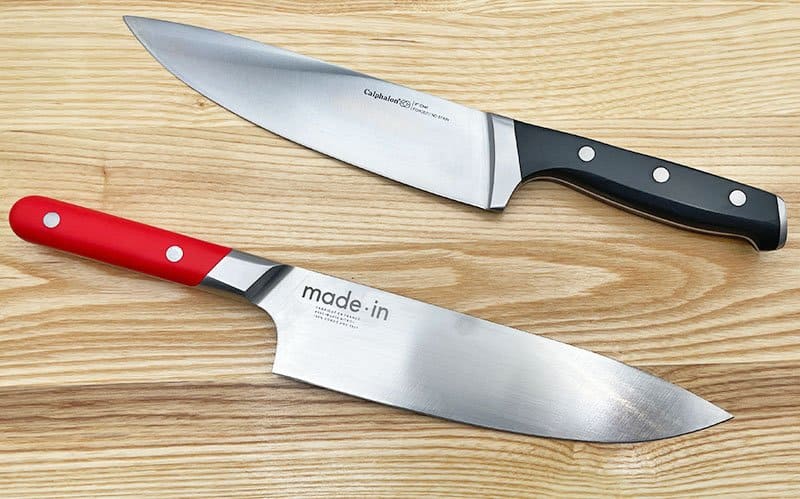
Calphalon and Made In both offer a variety of kitchen knives and knife sets. Let’s explore the major differences between both brands.
Knife Offerings
Calphalon primarily offers knife sets with a traditional knife block. Made In offers a few sets but sells most of its knives individually.
Calphalon Knives:
- Precision: This collection features high-carbon steel knife sets with a unique bar-shaped rivet on the handles. Each set offers forged and stamped knives, kitchen shears, and a self-sharpening knife block.
- Contemporary: These knives have a thick full bolster and comfortable contoured handles. Like other Calphalon knives, Contemporary offers self-sharpening knife blocks and labeling on the knife butts to identify the type of each prep knife.
- Classic: This is the most extensive and most affordable Calphalon knife collection. The knives are simply made with high-carbon steel and contoured handles. Sharpening engages every time you remove a knife from its slot in the block.
- Select by Calphalon: This collection includes knife blocks and a fruit and vegetable knife set made from high-carbon steel. These knives feature a full-tang design and an ergonomic handle made of either stainless steel or wrapped in black synthetic material.
Made In Knives:
- 8-inch Chef Knife: A forged all-purpose knife made from X50CrMoV15 steel.
- Santoku Knife: A multi-purpose kitchen knife with a hand scalloped blade to repel food.
- Nakiri Knife: Perfect for prepping vegetables, this forged, Japanese-inspired knife delivers straight, precise cuts.
- Carving Knife: This limited edition rustic-styled knife is the result of a collaboration with Tecovas, a maker of cowboy boots and western-inspired gear. It’s a full-tang, fully forged knife perfect for carving meat.
- Bread Knife: A French-made serrated knife designed to slice bread with ease. The forged, full-tang construction keeps the knife durable and steady as you slice.
- Paring Knife: A small but useful kitchen knife suitable for cutting small vegetables and fruit. The forged construction helps to keep it balanced and steady in your hands.
- 4-Piece Knife Set: A collection of knives featuring the chef’s knife, Nakiri, bread knife, and paring knife. All are forged knives made from X50CrMoV15 steel.
- Specialty Knives: A small offering of knives for specific tasks, including a champagne saber, oyster shucker, fishing knives, and a limited edition Yanagi (sushi) knife.
Materials and Construction
Calphalon uses high-carbon, no-stain German steel for its food prep knives, like the chef’s knife. These knives are forged, full-tang, and feature a full bolster. The brand uses Asian steel for its stamped steak knives.
Some Calphalon blades, including the Contemporary and Precision collections, are treated with a non-stick coating for efficient food release.
Made In knives are forged from a single piece of X50CrMoV15 steel. It’s high-quality German steel used by renowned cutlery brands like Wusthof and Zwilling. All knives feature a sloped half-bolster design, ideal for utilizing the pinch grip and sharpening the entire blade.
Made In knives are treated with nitrogen to boost corrosion resistance and prevent chipping. That’s important, given that Made In blades score 58-60 HRC on the Rockwell Scale. The higher the number, the harder the steel, and the harder the steel, the more the blade is prone to chipping.
Calphalon steel is much softer. In fact, out of the dozens of knife brands I’ve reviewed, Calphalon uses the softest steel. Calphalon Classic knife collections are 48-52 HRC; its Contemporary knives are 54-56 HRC; and Precision knives score between 56-58 HRC.
Soft steel is less prone to chipping, but it can’t tolerate a sharp edge and quickly dulls. Maybe that’s why Calphalon doesn’t specify the exact edge angles of its knives. Also, that could be why so many of its sets come with a self-sharpening block. That said, Calphalon knives are extremely sharp out of the box based on my testing. You can cut paper-thin slices of fruits and vegetables with ease.

By contrast, Made In is open about the edge angles on its knives. They are sharpened to a razor-sharp 12.5-degree angle on each side for a total edge angle of 25 degrees. For context, most premium Western-style knives are sharpened to a 14- or 15-degree angle per side, so Made In’s edges are exceptionally sharp.
As I mentioned, many Calphalon sets come with self-sharpening knife blocks. They feature a ceramic insert in each knife slot designed to sharpen a knife every time you pull it out of the block. Theoretically, this should ensure that your Calphalon knives are always sharp.
Made In uses a synthetic resin similar to polyoxymethylene (POM) for its knife handles. The blade is double-riveted to the handle.
Calphalon knife handles are either triple-riveted, bar-riveted, or rivet-free. The bar rivet design stands out from many of the knives on the market today. It’s a rectangular steel bar that is centered on the handle.
Calphalon handles vary by collection. They are either stainless steel or a mix of stainless steel and black, synthetic material.
Design
Let’s take a close look at chef’s knives from each brand and compare some of the features.
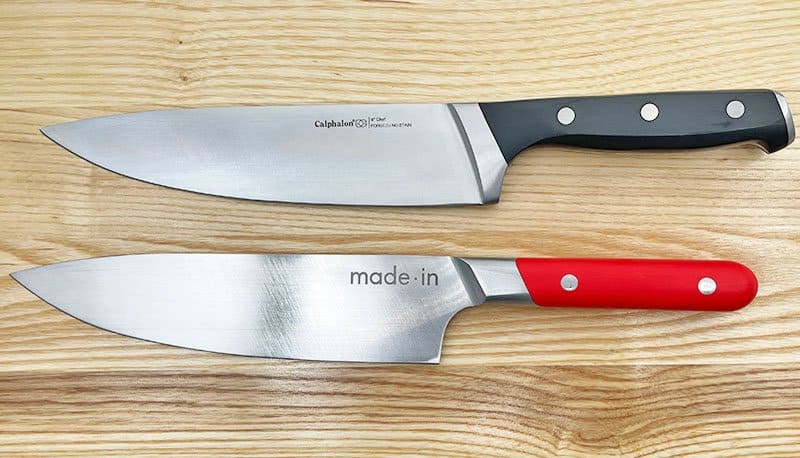
The Calphalon Classic Chef’s knife tries to imitate the style of some Wusthof or Zwilling collections. Yet, close up, it misses the mark.

The handles are bulky and better suited to larger hands. Despite its bulky feel, the handle is lightweight, making the knife unbalanced. The weight of the blade makes the knife tip forward as you cut.

Made In’s Chef’s knife feels noticeably better when you pick it up. It’s solid, hefty, and balanced from handle to point. The blade doesn’t immediately tip forward when you loosen your grip.

Calphalon’s full bolster is thick, making it difficult to hold. It prevents you from sharpening the entire edge and, if you prefer a pinch grip when prepping food, the Calphalon Classic Chef’s knife makes that nearly impossible to do comfortably.
With full bolsters (like Calphalon’s) the shape of the blade deteriorates over time as the blade gets sharpened down and the bolster remains thick.

Made In’s half bolster makes it easier to maneuver, and you get a fully sharpened edge.
Both brands offer a full-tang knife but Made In features a full exposed tang with two exposed rivets in the handle. Calphalon has a triple-riveted handle with an exposed tang.

Calphalon Classic handles are either black or stainless steel. Made In offers a choice of black, red, and wooden handles.
Made in stamps its logo and origin on both sides of the blade.

Calphalon’s logo and knife type appear on one side, and the country of origin is stamped on the other.

Examining the Calphalon Classic Chef’s knife, I noticed imperfections in the construction. The lines where the plastic handles meet the tang are not uniformly straight (a sign of poor quality control).
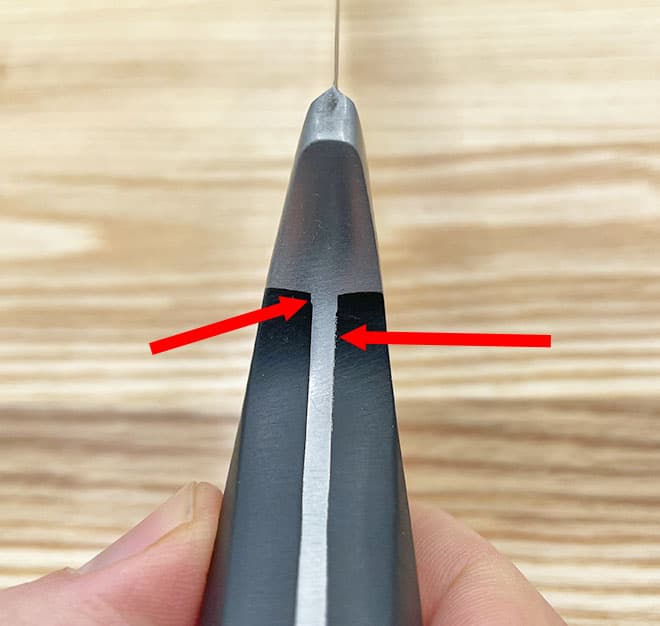
Where It’s Made
Calphalon sources German and Asian steel and manufactures its kitchen knives in China. The brand doesn’t offer much detail about the manufacturing process.
Made In knives are made in Thiers, France, by 5th-generation knife makers. In terms of knife history, Thiers is to France what Solingen (City of Blades) is to Germany. Both are well-known centers of cutlery. In fact, Thiers is called the Capital of Cutlery because people in the region have been making knives for 700 years.
Common Complaints
There’s a lot to like about Made In and Calphalon knives, but they’re not perfect. Here are the most common complaints.
Common complaints about Calphalon knives:
- Sharpness: Many customers claim they aren’t sharp out of the box, even with the self-sharpening knife blocks. Plus, Calphalon doesn’t disclose the sharpness of its edge angles.
- Durability: The knives lack heft and balance. They also feel fragile. There are also multiple reports of bent blade tips.
- Imperfections: Besides lack of sharpness and imbalance, there are physical imperfections in the construction. The plastic handle and knife tang are often misaligned.
- Poor quality: Calphalon knives have a discount feel. You can tell the materials and quality control is a major step down from Made In and other higher-end brands. In 2017, Calphalon recalled about 2 million knives from its Contemporary collection — they were breaking and causing injuries. This is somewhat surprising since the company’s cookware collections like Elite and Signature are well-built.
- Origin: The knives are made in China, and there is no information about the quality process and no mention of where the factory is located.
A few reported issues with Made In knives:
- Lack of options: With Made In, you get one option per knife. All of its chef’s knives are the same; all Santokus are the same — you get the idea. The color and material of the blade handle is the only variation. So, if you don’t like the shape of the handle or the thickness of the blade, there are simply no other options.
- Handle design: The straight handle may take some getting used to. Also, the gap from the handle to the blade is longer; someone with small hands may find it cumbersome to use.
- Accessibility: You can only buy Made In knives online (MadeInCookware.com). You can’t pick them up in a store and get a feel for them before purchasing. Made In does offer 45-day returns, though.
Price
If there is one category where Calphalon knives shine, it’s the price. They are significantly less expensive than Made In.
That said, Made In’s knives use high-quality materials and are the product of multi-generational precision knife makers in France (Calphalon knives are mass-produced in China). So that craftsmanship does come with a premium price. In other words, you get what you pay for.
You can see the current prices of Made In knives on MadeInCookware.com and Calphalon knives on Amazon and Calphalon.com.
Bottom Line: Should You Buy Calphalon or Made In?
Now that you know the key differences between Calphalon and Made In cookware and kitchen knives, it’s time to decide which brand is right for you.
Before I offer my recommendation, let’s recap the pros and cons of both brands.
Calphalon Pros:
- Calphalon is a pioneer of hard-anodized cookware and is an established brand.
- With Calphalon, you get a lot of variety in cookware and knife collections.
- You can purchase cookware at multiple price points, from budget to high-end.
- Calphalon’s PTFE-based non-stick is either two or three layers for better durability.
- Calphalon stainless steel cookware is either fully-clad or impact-bonded.
- Calphalon has a traditional cookware design that appeals to most home chefs.
- Calphalon offers both PTFE-based and PTFE-free non-stick cookware.
Calphalon Cons:
- Calphalon non-stick cookware is not induction compatible.
- All knives and most cookware is made in China, and there is no visibility into the manufacturing or quality control processes.
- Calphalon sells all of its knives in sets; you can’t buy an individual knife.
- Calphalon knives are not very sharp out of the box and have construction imperfections.
- Classic collection knives feel unbalanced; the blades are heavier than the handle.
Made In Pros:
- Made In uses high-quality materials and works with skilled craftspeople to manufacture its cookware and cutlery.
- Made In offers cookware in clad stainless steel, PTFE-based non-stick, carbon steel, copper, and enameled cast iron.
- The brand is used in Michelin-star kitchens.
- Made In is very transparent about the materials they use and the origin of its cookware and knives.
- Except for its copper cookware, Made In cookware is induction-compatible.
- Made In has a modern cookware design that is sleek and clean.
- According to my tests, Made In cookware heats faster and more evenly than Calphalon and retains heat better.
Made In Cons:
- Made In doesn’t offer multiple cookware or knife collections to choose from like its competitors.
- Overall, its cookware and knives are more expensive than most Calphalon collections.
- Made In’s Chef’s knife can be uncomfortable for people with small hands.
- You can only buy Made In’s offerings online, eliminating the chance to see and hold them in person to get a feel for the cookware and knives.
Bottom line — if you’re looking for a brand that puts quality first, go with Made In.
It’s made by expert artisans in the U.S., Italy, and France. The brand uses top-of-the-line materials but keeps prices lower than premium brands like All-Clad and Hestan because it’s sold exclusively online (MadeInCookware.com).
I recently named Made In the best professional-quality cookware. You’ll find Made In cookware and knives in Michelin-star restaurants like Le Bernardin in N.Y. and Alinea in Chicago.
However, if you want something more affordable, Calphalon’s hard-anodized aluminum non-stick cookware is one of the most reliable options in that category. It’s a trusted brand with a long track record of performance and durability.
That said, avoid Calphalon knives. The brand’s primary focus is cookware. Cutlery is a secondary product line, and the quality and detail (or lack thereof) raise concerns.
Although Calphalon knives have attractive pricing and self-sharpening knife blocks, the durability issues, dull edges, and unbalanced feel cancel out the savings. If price is a concern, Henckels and Misen are better, low-cost options.
Made In cookware and knives are available on MadeInCookware.com, where you can learn more and read hundreds of reviews. Calphalon is available in stores and online on Amazon and Calphalon.com.
Related Topics
- Made In vs. Misen: Which Cookware and Kitchen Knives Are Better?
- All-Clad vs. Made In: The Ultimate Cookware Comparison
- Is Made In Cookware Any Good? An In-Depth and Unbiased Review
- Made In vs. Wusthof: Which Kitchen Knives Are Better?
- Made In vs. Heritage Steel: 9 Key Differences Explained
- Are Made In Non-Stick Pans Worth Buying? An In-Depth Review
- Made In Carbon Steel Cookware (In-Depth Review)
- Made In 8-Inch Chef’s Knife Review (With Pictures)
- Made In vs. Caraway Cookware: 11 Key Differences
- Where Is Made In Cookware Made? (Solved!)
- Are Calphalon Kitchen Knives Any Good? An In-Depth Review
- Is Calphalon Cookware Any Good? An In-Depth Review
- What Is the Best Calphalon Cookware Set? (Top 5 Reviewed)
- Tramontina vs. Calphalon Cookware: 10 Key Differences
- Calphalon vs. Anolon Cookware: What’s the Difference?
- Calphalon vs. Cuisinart: Which Cookware Is Better?
- All-Clad vs. Calphalon: How Does Their Cookware Compare?


